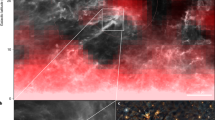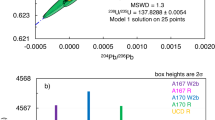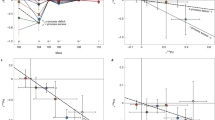Abstract
Fossil meteoritic records of short-lived, now-extinct radionuclides provide crucial high-resolution temporal information about the events, processes and activity of the Sun during the early phases of Solar System formation1. The proposed genesis of one such radionuclide,10Be, by spallation reactions of carbon and oxygen2,3,4,5 led to the hypothesis of enhanced irradiation in the early Solar System6,7,8. An alternative scenario of production of 10Be (half-life t1/2 = 1.386 ± 0.016 million years9) by a neutrino process in a supernova arising from the core collapse of a low-mass star (11.8 solar masses, M⊙) has recently been suggested10 and can explain the observed abundance of 10Be in the early Solar System. Here, we report well-resolved excesses in 7Li/6Li of up to ~21.5% in a calcium- and aluminium-rich inclusion (CAI) from the Efremovka meteorite that correlate with 9Be/6Li, suggestive of in situ decay of 7Be. The in situ decay of 7Be to 7Li, with a characteristic half-life of 53.12 ± 0.07 days11, entails multiple episodes of enhanced irradiation in the early Solar System, which have been observed recently in other Sun-like stars12,13. The short half-life of 7Be limits its production by interaction of solar energetic particles (SEPs) with the nebular gas and solids, and provides constraints on the genealogy and chronology of CAIs. Irradiation of the solid and gaseous precursors of CAIs of solar composition by a superflare (X-ray luminosity approximately 1032 erg s−1) during the terminal phase of class I or II of the pre-main-sequence stages of the Sun explains the isotopic properties, distinctive petrographic features and diffusivity constraints in the CAI.
This is a preview of subscription content, access via your institution
Access options
Access Nature and 54 other Nature Portfolio journals
Get Nature+, our best-value online-access subscription
$29.99 / 30 days
cancel any time
Subscribe to this journal
Receive 12 digital issues and online access to articles
$119.00 per year
only $9.92 per issue
Buy this article
- Purchase on Springer Link
- Instant access to full article PDF
Prices may be subject to local taxes which are calculated during checkout


Similar content being viewed by others
Data availability
The data that support the plots within this paper and other findings of this study are available from the corresponding author upon reasonable request.
References
Dauphas, N. & Chaussidon, M. A perspective from extinct radionuclides on a young stellar object: the Sun and its accretion disk. Annu. Rev. Earth Planet. Sci. 39, 351–386 (2011).
Chaussidon, M., Robert, F. & McKeegan, K. D. Li and B isotopic variations in an Allende CAI: evidence for the in situ decay of short-lived 10Be and for the possible presence of the short-lived nuclide 7Be in the early Solar System. Geochim. Cosmochim. Acta 70, 224–245 (2006).
MacPherson, G. J., Huss, G. R. & Davis, A. M. Extinct 10Be in type A calcium-aluminum-rich inclusions from CV chondrites. Geochim. Cosmochim. Acta 67, 3165–3179 (2003).
Marhas, K. K., Goswami, J. N. & Davis, A. M. Short-lived nuclides in hibonite grains from Murchison: evidence for Solar System evolution. Science 298, 2182–2185 (2002).
McKeegan, K. D., Chaussidon, M. & Robert, F. Incorporation of short-lived 10Be in a calcium–aluminum-rich inclusion from the Allende meteorite. Science 289, 1334–1337 (2000).
Sugiura, N., Shuzou, Y. & Ulyanov, A. A. Beryllium–boron and aluminum–magnesium chronology of calcium–aluminum-rich inclusions in CV chondrites. Meteorit. Planet. Sci. 36, 1397–1408 (2001).
Wielandt, D. et al. Evidence for multiple sources of 10Be in the early Solar System. Astrophys. J. Lett. 748, 1–7 (2012).
Srinivasan, G. & Chaussidon, M. Constraints on 10Be and 41Ca distribution in the early Solar System from 26Al and 10Be studies of Efremovka CAIs. Earth Planet. Sci. Lett. 374, 11–23 (2013).
Chmeleff, J., von Blanckenburg, F., Kossert, K. & Jakob, D. Determination of the 10Be half-life by multicollector ICP-MS and liquid scintillation counting. Nucl. Instrum. Method Phys. Res. 268, 192–199 (2010).
Banerjee, P., Qian, Y.-Z., Heger, A. & Haxton, W. C. Evidence from stable isotopes and 10Be for Solar System formation triggered by a low-mass supernova. Nat. Commun. 7, 136–139 (2016).
Jaeger, M., Wilmes, S., Kolle, V., Staudt, G. & Mohr, P. Precision measurement of the half-life of 7Be. Phys. Rev. C 54, 423–424 (1996).
Maehara, H. et al. Superflares on solar-type stars. Nature 485, 478–481 (2012).
Wolk, S. J. et al. Stellar activity on the young suns of Orion: COUP observations of K5-7 pre-main-sequence stars. Astrophys. J. Suppl. Ser. 160, 423–449 (2005).
Desch, S. J., Connolly, H. C. & Srinivasan, G. An interstellar origin for the beryllium 10 in calcium-rich, aluminum-rich inclusions. Astrophys. J. 602, 528–542 (2004).
Leya, I. Cosmogenic effects on 7Li/6Li, 10B/11B, and 182W/184W in CAIs from carbonaceous chondrites. Geochim. Cosmochim. Acta 75, 1507–1518 (2011).
MacPherson, G. J. in Meteorites and Cosmochemical Processes: Treatise on Geochemistry 2nd edn (eds Holland, H. D. & Turekian, K. K.) 139–179 (Elsevier, Oxford, 2014).
Amelin, Y. et al. U-Pb chronology of the Solar System’s oldest solids with variable 238U/235U. Earth Planet. Sci. Lett. 300, 343–350 (2010).
Bonal, L., Quirico, E., Bourot-Denise, M. & Montagnac, G. Determination of the petrologic type of CV3 chondrites by Raman spectroscopy of included organic matter. Geochim. Cosmochim. Acta 70, 1849–1863 (2006).
Goswami, J. N., Srinivasan, G. & Ulyanov, A. A. Ion microprobe studies of Efremovka CAIs. 1. Magnesium isotope composition. Geochim. Cosmochim. Acta 58, 431–447 (1994).
Goswami, J. N., Marhas, K. K. & Sahijpal, S. Did solar energetic particles produce the short-lived nuclides present in the early Solar System? Astrophys. J. 549, 1151–1159 (2001).
Bricker, G. E. & Caffee, M. W. Solar wind implantation model for 10Be in calcium–aluminum inclusions. Astrophys. J. 725, 443 (2010).
Gounelle, M. et al. The irradiation origin of beryllium radioisotopes and other short-lived radionuclides. Astrophys. J. 640, 1163–1170 (2006).
Leya, I., Halliday, A. N. & Wieler, R. The predictable collateral consequences of nucleosynthesis by spallation reactions in the early Solar System. Astrophys. J. 594, 605–616 (2003).
Sahijpal, S. & Soni, P. Numerical simulations of the production of extinct short-lived nuclides by magnetic flaring in the early Solar System. Meteor. Planet. Sci. 42, 1005–1027 (2007).
Sossi, P. A. et al. Early Solar System irradiation quantified by linked vanadium and beryllium isotope variations in meteorites. Nat. Astron. 1, 1–5 (2017).
Stolper, E. & Paque, J. M. Crystallization sequences of Ca–Al-rich inclusions from Allende—the effects of cooling rate and maximum temperature. Geochim. Cosmochim. Acta 50, 1785–1806 (1986).
Richter, F., Watson, B., Chaussidon, M., Mendybaev, R. & Ruscitto, D. Lithium isotope fractionation by diffusion in minerals. Part 1: Pyroxenes. Geochim. Cosmochim. Acta 126, 352–370 (2014).
Larsen, K. K. et al. Evidence for magnesium isotope heterogeneity in the solar protoplanetary disk. Astrophys. J. Lett. 735, L37 (2011).
Mishra, R. K. & Chaussidon, M. Timing and extent of Mg and Al isotopic homogenization in the early inner Solar System. Earth Planet. Sci. Lett. 390, 318–326 (2014).
Hsu, W. B., Guan, Y. B., Leshin, L. A., Ushikubo, T. & Wasserburg, G. J. A late episode of irradiation in the early Solar System: evidence from extinct 36Cl and 26Al in meteorites. Astrophys. J. 640, 525–529 (2006).
Jacobsen, B. et al. Formation of the short-lived radionuclide 36Cl in the protoplanetary disk during late-stage irradiation of a volatile-rich reservoir. Astrophys. J. Lett. 731, 28–33 (2011).
Spivack, A. J., Beckett, J. R., Hutcheon, I. D., Wasserburg, G. J. & Stolper, E. M. The partitioning of trace-elements between melilite and liquid—an experimental-study with applications to type-B CAI. Chem. Geol. 70, 155–155 (1988).
Beckett, J. R. et al. Crystal chemical effects on the partitioning of trace elements between mineral and melt: an experimental study of melilite with application to refractory inclusions from carbonaceous chondrites. Geochim. Cosmochim. Acta 54, 1755–1774 (1990).
Lundstrom, C. C. et al. Trace element partitioning between type B CAI melts and melilite and spinel: Implications for trace element distribution during CAI formation. Geochim. Cosmochim. Acta 70, 3421–3435 (2006).
Lodders, K. & Fegley, B. Chemistry of the Solar System (RSC, Cambridge, 2011).
Krot, A. N., Nagashima, K., Kooten, E. M. M. & Bizzarro, M. High temperature rims around calcium–aluminum-rich inclusions from the CR, CB and CH carbonaceous chondrites. Geochim. Cosmochim. Acta 201, 155–184 (2017).
Ulyanov, A. A. & Kolesov, G. M. REE in CAI’s of the Efremovka chondrite. In 15 th Lunar Planet. Science Conf. 1441 (LPI, 1984); http://www.lpi.usra.edu/meetings/lpsc1984/pdf/1442.pdf
Ulyanov, A. A., Ustinov, V. I., Gavrilov, E. Ya. & Shukolyukov, Yu. A. Isotopic composition of oxygen in the Efremovka CAI’s. In 16 th Lunar Planet. Science Conf. 1441 (LPI, 1985).
Murty, S. V. S., Nishiizumi, K. & Goswami, J. N. Cosmogenic records in Efremovka CV3 meteorite. In 27th Lunar Planet. Science Conf. 1462 (LPI, 1996); http://www.lpi.usra.edu/meetings/lpsc1996/pdf/1462.pdf
Chaussidon, M. & Robert, F. Lithium nucleosynthesis in the Sun inferred from the solar-wind 7Li/6Li ratio. Nature 402, 270–273 (1999).
Koning, A. J., Hilaire, S. & Duijvestijn, M. C. TALYS-1.0. In Int. Conf. Nuclear Data for Science and Technology ND 2007, https://doi.org/10.1051/ndata07767 (EDP Sciences, 2007).
Lange, H. J. et al. Production of residual nuclei by α-induced reactions on C, N, O, Mg, Al and Si up to 170 MeV. Appl. Radiat. Isot. 46, 93–112 (1995).
Ramaty, R., Kozlovsky, B. & Lingenfelter, R. E. Light isotopes, extinct radioisotopes, and gamma-ray lines from low-energy cosmic-ray interactions. Astrophys. J. 456, 525–540 (1996).
Mishra, R. K. & Marhas, K. K. Abundance of 60Fe inferred from nanoSIMS study of QUE 97008 (L3. 05) chondrules. Earth Planet. Sci. Lett. 436, 71–81 (2016).
Cherniak, D. J. Cation diffusion in feldspars. Rev. Mineral. Geochem. 72, 691–733 (2010).
Ludwig, K. R. User’s Manual. Isoplot 4.1: A geochronological toolkit (Microsoft Excel, 2012).
Acknowledgements
Secondary ion mass spectrometry (SIMS) at the Physical Research Laboratory, Ahmedabad, India is supported partially by financial grants from Department of Space, Government of India. K.K.M. acknowledges support for the research from Scientific and Engineering Research Board, India (SERB-WES grant no. SB/WEA-007/2013). R.K.M. acknowledges financial support during the preliminary preparation of the manuscript at NASA Johnson Space Center, Houston under a NASA post-doctoral programme (NPP) fellowship administered by the Oak Ridge National Laboratory associated universities, and from the Alexander Von Humboldt foundation during the Humboldt fellowship at Ruprecht-Karls University, Heidelberg. We acknowledge discussions over the years with J. N. Goswami, M. Chaussidon and J. I. Simon. We thank M. Trieloff and J. B. Patel for comments. V. Goyal, Sameer and A. Cisneros helped in the preparation of Fig. 2. We dedicate this paper to the late Professor Devendra Lal.
Author information
Authors and Affiliations
Contributions
R.K.M. and K.K.M. planned the project and contributed equally towards analysis of the data. K.K.M. performed the ion probe analysis and model calculation. R.K.M. and K.K.M. discussed the results and wrote the manuscript. Reprints and permissions information is available at www.nature.com/reprints.
Corresponding author
Ethics declarations
Competing interests
The authors declare no competing interests.
Additional information
Journal peer review information: Nature Astronomy thanks Don Burnett and the other anonymous reviewer(s) for their contribution to the peer review of this work.
Publisher’s note: Springer Nature remains neutral with regard to jurisdictional claims in published maps and institutional affiliations.
Supplementary information
Supplementary Information
Supplementary Figures 1–6, Supplementary Table 1.
Rights and permissions
About this article
Cite this article
Mishra, R.K., Marhas, K.K. Meteoritic evidence of a late superflare as source of 7Be in the early Solar System. Nat Astron 3, 498–505 (2019). https://doi.org/10.1038/s41550-019-0716-0
Received:
Accepted:
Published:
Issue Date:
DOI: https://doi.org/10.1038/s41550-019-0716-0
This article is cited by
-
Solar evolution and extrema: current state of understanding of long-term solar variability and its planetary impacts
Progress in Earth and Planetary Science (2021)



